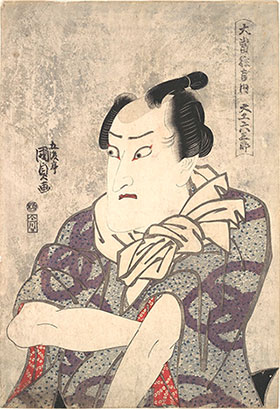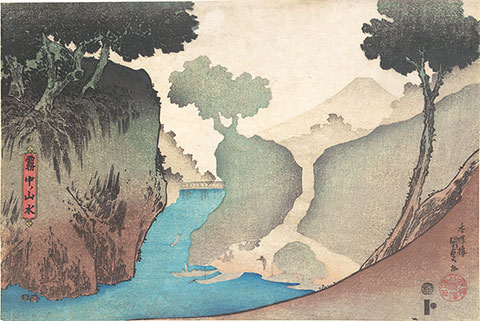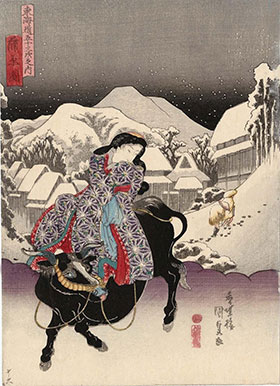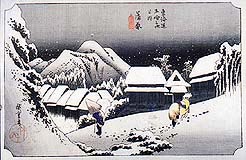

Utagawa Kunisada (歌川國貞)
|
 Utagawa Kunisada (歌川國貞) was the most celebrated actor-print designer of the nineteenth century, and certainly the most prolific. In 1800-1801, at the age of fourteen or fifteen, he became a pupil of Utagawa Toyokuni I (歌川豊國 1769-1825) and took the artist name "Kunisada" (國貞) soon thereafter (see signature image at immediate right). In 1/1807 he produced his first independent work — an illustrated promotional brochure for perfumed oil made by Yorozuya Shirobei. The text was wirtten by the eminent novelist Takizawa Bakin (滝沢馬琴 1767-1848) and titled "Gate of immortality, New Year's water for cosmetics (Oi senu kado keshô no wakamizu). Distributed as a New Year's gift, it was not a commercial production, although it was later sold as such in a trade edition in 1809.
Utagawa Kunisada (歌川國貞) was the most celebrated actor-print designer of the nineteenth century, and certainly the most prolific. In 1800-1801, at the age of fourteen or fifteen, he became a pupil of Utagawa Toyokuni I (歌川豊國 1769-1825) and took the artist name "Kunisada" (國貞) soon thereafter (see signature image at immediate right). In 1/1807 he produced his first independent work — an illustrated promotional brochure for perfumed oil made by Yorozuya Shirobei. The text was wirtten by the eminent novelist Takizawa Bakin (滝沢馬琴 1767-1848) and titled "Gate of immortality, New Year's water for cosmetics (Oi senu kado keshô no wakamizu). Distributed as a New Year's gift, it was not a commercial production, although it was later sold as such in a trade edition in 1809.
In 3/1807, Kunisada provided designs in the genre of bijinga (pictures of beautiful women: 美人画) for the series Keisei junitoki (Twelve hours of the courtesans: 傾城十二時). These early bijinga were somewhat immature and suffered in comparison to his designs in this genre even just two years later in 1809. Kunisada's first theatrical print was made in 3/1808, a fan print (uchiwa: 團扇) portraying Matsumoto Kôshirô V as Nikki Danjo, published by Senzaburô (Dansendô). The following month, Kunisada depicted the Osaka-based actor Nakamura Utaemon III performing at the Nakamura-za in Edo as Yojirô the monkey trainer in the play Oshun Denbei. Soon after, he completed a triptych of beauties and then embarked on illustrations for books (ehon or picture books: 絵本). He would continue to design for ehon throughout his career, providing huge numbers of images for actor-print books and illustrated popular fiction. Even early on, he was prodigiously creative in this genre, as in 1808 when he contributed to no fewer then fourteen ehon.
It has been estimated that as many as 15,000 to 20,000 print designs were issued from his studio, as well as thousands of illustrations for woodblock-printed books (ehon). Given that some of these prints were issued in thousands of impressions, the number of actual printed sheets sold by the various publishers over Kunisada's long career must have been astounding. Little wonder that his prints are among the most frequently encountered in collections around the world. With such an enormous output, it isn't surprising that Kunisada's designs were uneven in quality, which has compromised his reputation. Moreover, as a large percentage of his works involved actors, the opaqueness of the kabuki theater to the uninitiated western observer did little to endear him to the early twentieth-century collectors, and that "fault" still persists to some extent today. Not helping matters were the many compositions that seemed perfunctory in their execution, or large numbers of respectable designs found in late impressions and in poor condition, which does them little justice. Whether his students had a hand in some or most of the more inferior products from Kunisada's studio is difficult to determine, but it is likely. Nevertheless, the very best of his designs, which span his entire career, number among the masterpieces of nineteenth-century ukiyo-e.
One need look no further than certain of Kunisada's early actor prints to discover a confident and inventive spirit expressed in portraits from the kabuki stage. At the top right is Kunisada's depiction of Onoe Matsusuke II (尾上松助 later called Onoe Kikugorô III, 尾上 菊五郎) as the carpenter (daiku, 大工) Rokusaburô (六三郎) in Mijikayo ukina no chirashi-gaki (短夜仇散書), probably the production given in 7/1813 at the Nakamura-za, Edo. The design comes from a set, published in 1815-16, titled ôatari kyôgen no uchi (Series of big-hit plays: 大当狂言ノ内), which looks back at selected actors and performances from a few years prior to its publication. Finely printed and embellished with mica backgrounds, the series shows Kunisada at his best and compares favorably with any of his later achievements in actor portraiture.
 |
| Kunisada: Yakusha sanjûrokkasen (Thirty-six selected actors: 俳優三十六花撰), 1/1835 (R) Ichikawa Ebizô V and (L) Bandô Mitsugorô IV |
One of the numerous actor-portrait books illustrated by Kunisada was the volume titled Yakusha sanjûrokkasen (Thirty-six selected actors: 俳優三十六花撰) from 1/1835, with texts by Ryûtei Tanehiko that was published by Eijudô (Nishimura Yohachi) and Nakamuraya Katsugorô. Kunisada was responsible for the actor portraits, while the artist Totoya Hokkei (1780-1850) contributed three landscapes featuring the homes of three of the actors. The title puns on sanjûrokassen (Thirty-six poetic immortals: 三十六歌仙) whose poems were compiled by the minor poet and critic Fujiwara no Kintô (966-1041) around 1009-1011. Indeed, Ryûtei Tanehiko's preface includes a brief history of the 36 classical poets and explains why Kunisada chose them as a subject. Moreover, the actor portraits are accompanied by poems purportedly composed by the actors. At present, only one volume with 12 portraits is known; apparently, the remaining 24 likenesses were never published. In the two images below, Ichikawa Ebizô V (previously Danjûrô VII) is on the right and Bandô Mitsugorô IV (previously Minosuke II) is on the left.
We do not usually associate the landscape print with Kunisada, but he did, on at least one occasion, create some excellent landscapes for a set of ten untitled prints published by Yamaguchiya Tôbei (Kinkôdô) in the early 1830s. They were probably issued in response to the recent success of Katsushika Hokusai's Fugaku sanjûrokkei ("Thirty-six views of Mount Fuji"), also issued in the early 1830s. The compositions were based in part on the Nanga-school artist Kawamura Bumpô's influential Bumpô sansui gafu (Bumpô's album of landscape painting: 文鳳山水画譜), issued posthumously by Bunchôdô in 1824, but Kunisada's prints combined western influences with Kyoto-based literati painting styles. A few of these landscapes are considered masterpieces of the genre. Surviving impressions from this set are uncommon and all are well printed, which suggests that they were issued in relatively small editions.
 |
| Kunisada:Muchû no sansui (Muchû in the mist: 霧中山水), c. 1832 |
The scene shown immediately above is entitled Muchû no sansui (Muchû in the mist: 霧中山水), published by Yamaguchiya Tôbei (山口屋藤兵衛) of the firm Kinkôdô, circa 1832. It is an atmospheric scene, revealing Kunisada's sensitivity to the nuances of light, color, and form to be found in nature. Of particular interest is the strength and clarity of the left-side cliff in contrast with the soft, hazy trees and cliffs in the center, along with a faint Fuji in the far distance. (The earliest state, printed masterfully, depicts even more ethereal trees and cliffs than the example given here, and offers a view of only a blue-peaked Fuji with the sacred mountain otherwise shrouded in mist.) The print is signed Kôchôrô Kunisada (香蝶楼國貞).

 Kunisada did not continue to design landscapes. Perhaps the public wanted only designs of actors and women from Kunisada, the master of Utagawa-style yakusha-e (actor prints: 役者絵) and bijinga (prints of beautiful women: 美人画). In any case, he never designed another set with landscapes as a central subject. Instead, like many other artists, he used landscapes as backgrounds for figure prints. One of his earlier efforts was a fine set of koban prints (small format, in this case engraved four to an ôban block) circa 1824-25 of geisha posed before landscapes. They were beautifully printed and featured limited use of the imported synthetic pigment bero-ai ("Berlin blue"), an early example of its use in ukiyo-e printmaking.
Kunisada did not continue to design landscapes. Perhaps the public wanted only designs of actors and women from Kunisada, the master of Utagawa-style yakusha-e (actor prints: 役者絵) and bijinga (prints of beautiful women: 美人画). In any case, he never designed another set with landscapes as a central subject. Instead, like many other artists, he used landscapes as backgrounds for figure prints. One of his earlier efforts was a fine set of koban prints (small format, in this case engraved four to an ôban block) circa 1824-25 of geisha posed before landscapes. They were beautifully printed and featured limited use of the imported synthetic pigment bero-ai ("Berlin blue"), an early example of its use in ukiyo-e printmaking.
In the late 1830s Kunisada designed an interesting set of prints in chûban format titled Tôkaidô gojûsan tsugi no uchi (Fifty-three Stations of the Eastern Sea Road: 東海道五十三對). He adapted all the landscape backgrounds from Hiroshige's popular Tôkaidô set of the same title from the early 1830s. The example shown at the right depicts a beauty traveling on an ox, while above a scalloped cloud there is a compressed view of Hiroshige's famous Kambara yoru no yuki ("Night Snow at Kambara") — compare the original view above left.
In 1852, an extraordinary demand developed for figure prints with background landscapes, and Kunisada and his publishers responded, producing in a single year at least eleven series with as many as 400 total designs — an amazing frenzy of printmaking for one genre by one artist within so short a time span. The landscape elements were drawn in the Hiroshige style, but they were always subordinate to the actor placed before them. (In a related series, Tôto komei kaiseki zukushi, "A Complete Set of Famous Restaurants in the Eastern Capital"), Hiroshige himself provided landscapes and still lifes for inset pictures, while Kunisada designed the portraits of the actors.)
 There are many bijinga that one might select to illustrate such works by Kunsada. Perhaps a portrayal from around the mid-point of his career (c. 1830) will suffice. Kunisada's series Ukiyo jinsei tengankyô (Types of the floating world seen through a physiognomist's glass: 浮世人精天眼鏡) consists of ten known designs, each with extended inscriptions purporting to describe the characteristics of different types of female personalities as interpreted in the manner of a physiognomist. This was a fanciful conceit for a theme featuring the "varieties" of women in ukiyo-e prints, one that Kitagawa Utamaro (多川歌麿 c. 1753-1806) had taken up in masterful fashion three and four decades earlier in his series Fuju ninsô juppon (Ten classes of women’s physiognomy: 婦女人相十品), c. 1792-94, and Bijin gomensô (Five faces of beauties: 美人五面相), c. 1802, respectively.
There are many bijinga that one might select to illustrate such works by Kunsada. Perhaps a portrayal from around the mid-point of his career (c. 1830) will suffice. Kunisada's series Ukiyo jinsei tengankyô (Types of the floating world seen through a physiognomist's glass: 浮世人精天眼鏡) consists of ten known designs, each with extended inscriptions purporting to describe the characteristics of different types of female personalities as interpreted in the manner of a physiognomist. This was a fanciful conceit for a theme featuring the "varieties" of women in ukiyo-e prints, one that Kitagawa Utamaro (多川歌麿 c. 1753-1806) had taken up in masterful fashion three and four decades earlier in his series Fuju ninsô juppon (Ten classes of women’s physiognomy: 婦女人相十品), c. 1792-94, and Bijin gomensô (Five faces of beauties: 美人五面相), c. 1802, respectively.
In the design shown here, Kunisada portrayed a high-ranking courtesan intent on inscribing a love letter. While holding a writing brush, she clenches a tissue between her teeth, suggesting that the content of her missive and the object of her affection are bringing up rather strong emotions. Although noted especially for his actor prints, Kunisada's corpus of bijinga included many of the best examples of the genre in his day. The long inscription at the upper left was written, on request, by the author of popular fiction Santô Kyôzan (1769-1858), who signed "Santô an Kyôzan" (山東庵京山). He was the younger brother of the celebrated "floating-world" writer Santô Kyôden (1761-1816).
Kunisada died on January 12, 1865, according to the western Gregorian calendar (coresponding to 12/15/1864 on the Japanese lunar calendar). He left behind a prodigious output, which at its best ranked with the finest prints of the late Edo period.
Kunisada I Names:
Note: Signatures on ukiyo-e prints frequently end with the characters for "drawn by" (ga: 画), as is the case with the two signature images shown above at the top right, or "painted by" (hitsu [fude]: 筆).
Surname:
Utagawa (歌川)
Art names (geimei):
Kunisada (國貞) from 1807 until 1843
Toyokuni (豊國) from 1844
Pseudonyms (gô):
Kunisada's many art pseudonyms (gô) are sometimes found in use at non-continuous intervals over a few or even many years. There are also a various "special" signatures that were, it seems, linked with particular occasions, for example, "Ukabuse" [Oukamuse] (於浮瀬) 1821-22 (refers to a famous restaurant in Osaka). Moreover, there are prefixes that are not gô, such as "ôju" (to satisfy the demand or by demand: 応需), "ôkō" (to satisfy the taste: 應好), "shimoto no ôju" (to satisfy the publisher's demand: 梓元乃応需) and "ôju sai" (to satisfy the demand again: 応需再). Moreover, from 1861, Kunisada often included his age with the signature; before that year, it was rare that he would do so.
The list below offers information on what seem to be Kunisada's primary gô, which are given in order of estimated first appearance. Occasionally, two of the gô might be found together in a single signature, or even combined with the surname "Utagawa," as is the case with Gototei and Kôchôrô.
Gototei (五渡亭) 1809 - 1845
Gepparô (月波楼) 1811 - 1813
Ichiyûsai (一雄齋) 1811 - c. 1817
Kinraisha (琴雷舎]) 1813 - c. 1817 (said to be derived from his father's poetry name Gokyotei Kinrai
Kôchôrô (香蝶楼) 1824-1861 (see image of signature with yellow background at top right)
Hanabusa Itchô [Ittai] (英一蝶) c. 1820s - 1858
Tôjuen (桃樹園) 1827 - 1830s (only on surimono?)
Matahei (又平) 1830s (shunga)
Ichiyôsai (一陽齋] c. 1840s - 1861
Kokuteisha (國貞舎) c. 1847 - 1851
Ichisensai (一壽齋) at least by 1848 (found in ehon)
Hokubaiko (北梅戸) 1845
Eishû (英舟) After 1844?
Fubô-sanjin (富眺山人) After 1844?
Yanagishima (柳島) After 1844; Kunisada was called "Yanagishima Toyokuni," referring to where he lived.
Fu-chôan (富眺庵) c. 1853 - 1858
Hinashi (雛獅) c. 1858 - 1859
From around 1850, nearly all signatures were enclosed within a toshidama (年玉) cartouche with various color fills (red, yellow, green, blue). For an example, see the image at the top far right. The cartouche was the sign of the Utagawa artist lineage, with the ideogram for "year" (toshi 年) written in highly stylized script at the upper right of a circle or ball (dama 玉). Utagawa Toyokuni I, founder of the lineage, appears to have been the first to use the toshidama seal around 1808 in his gôkan (“combined volumes,” popular novels issued in multi-volume sets: 合卷).
Pupils of Kunisada I
The list of pupils given below is a provisional one. Unless otherwise noted, these artists were pupils of Kunisada who worked in Edo. Their associations with Kunisada ranged from long-term apprenticeships in the studio to those who benefited from some brief tutelage by the master. Although these artists number more than 40 print designers, they surely do not represent the entire roster of pupils who spent time in the Kunisada studio. As for the small number of Osaka artists included below, they were, for the most part, pupils of Osaka masters who also happened to study with Kunisada in Edo, probably only for brief periods of time.
Names given within parentheses are selected gô included to help identify the artists. Some alternate geimei are also indicated after the gô. To avoid excessive repetition, Japanese characters for the surname "Utagawa" (歌川) are not indicated. The Japanese characters for a few names cited in English by other sources have not yet been confirmed and thus have been omitted. Artists are listed in approximate order of first known works.
Utagawa Kunishige I (國重 Nagasaki 長崎 Baigansai 梅丸齋; geimei: Shigeharu 重春 act. c. 1804-1818) Osaka
Utagawa Sadahide (貞秀 Gountei 五雲亭 Gyokuransai 玉蘭齋 1807-1879)
Utagawa Sadashige (貞繁 act. c. 1810s-1820s)
Utagawa Sadakame (貞歌女 act. c. 1818-1830)
Utagawa Sadatora (貞虎 Gofûtei 五風亭 act. c. 1818-1844)
Utagawa Sadafusa (貞房 Gokitei 五亀亭 act. c. 1818-early 1850s) Edo, then Osaka (pupil of Shigeharu, 重春)
Utagawa Nobusada (信貞 act. c. 1819-early 1830s), Osaka (studied there with Shigeharu, 重春)
Utagawa Sadakage (貞景 Gokitei 五湖亭 act. c. 1820s-1830s), Osaka
Utagawa Kunisada II (國貞 Ichijusai 一壽齋; geimei: Kunimasa III 國政 Toyokuni IV 豊國 act. c. 1823-1880)
Utagawa Sadahiro I (貞廣 Gochôtei 五蝶亭 act. c. late 1820s-mid-1850s), Osaka; with Kunisada c. 1828
Utagawa Sadachika (貞周 act. c. 1830-1844)
Utagawa Sadahisa (貞久 act. c. 1830-1848)
Utagawa Sadakatsu (貞勝 Takigawa 多㐂川 act. c. 1830-1848)
Utagawa Sadakiyo (貞清 act. c. 1830-1844)
Utagawa Sadakuni (貞國 act. c. 1830-1844)
Utagawa Sadamine (act. c. 1830-1844) different artist from later Sadamine
Utagawa Sadanao (貞猶 act. c. 1830-1844)
Utagawa Sadaoka (定岡 Gakutei 岳亭 act. c. 1830-1844)
Utagawa Sadataka (貞孝 act. c. 1830-1844)
Utagawa Sadatsuna (貞綱 Gofûtei 五風亭 act. c. 1830-1844)
Utagawa Sadamine (act. c. 1830-1850s) different artist from earlier Sadamine
Utagawa Sadatoshi (貞年 act. c. 1830-1850s)
Utagawa Yoshitoyo (芳豊 Ichiryûsai 一龍齋 1830-1866) also member of Utagawa Kuniyoshi school
Utagawa Kunimori (國盛; geimei: Shunshô 春升 act. c. 1830-1861)
Utagawa Sadamasu (貞升 Ichijusai 一樹齋; geimei: Kunimasu 國升 act. c. 1830-1854), Osaka artist pupil of Kunisada in Edo
Utagawa Sadamasu (貞益 act. c. 1850)
Hasegawa Sadanobu I (貞信 1809-1879; act. c. 1834–79), Osaka
Utagawa Sadatsugu (貞次 Gochôtei 五蝶亭 act. c. 1835–39), Osaka
Utagawa Sadayoshi (貞芳 Baisôen 梅窓園 Kaishuntei 魁春亭 Gohyôtei 五瓢亭 act. c. 1837-1853), Osaka
Utagawa Kuniteru II (國輝 Yôsai 曜齋 Ichiyôsai 一曜齋 1830-1874)
Utagawa Kunihisa II (國久 Ichiryûsai 一龍齋 1832-1891) Edo and Yokohama
Toyohara Kunichika (豊原國周 1835-1900) later head of Kunichika school
Utagawa Kuniaki I (國明 act. c. 1840s-1860s)
Utagawa Kuniaki II (國明 Ichiôsai 一凰齋 and Ippôsai 一鳳齋 1835-1888)
Utagawa Kunimaro (國麿 Ichiensai 一圓齋 and Shôchôrô 枩蝶樓; geimei: Kikukôshi 菊越 act. c. 1845-1875)
Utagawa Hirosada (廣貞 Gosotei 五粽亭 and Konishi 小西 c. 1847-1863) Osaka artist studied with Kunisada in Edo
Utagawa Kunitomi II (国富 act. c. 1848-1854)
Utagawa Kunishige I (國重 act. c. 1848-1860) Edo artist, not Kunishige/Shigeharu in Osaka
Utagawa Kunitoku (國得 act. c. 1832-early Meiji)
Utagawa Kunimasa IV (國政 Baidô 梅堂; geimei: Kunisada III 國貞 Hosai 豊齋 Kôchôrô 香朝樓 act. c. 1848-1920)
Utagawa Kunifuku (國福 Isshôsai 一昇齋 act. c. 1854-1860)
Utagawa Kunikazu (國員 Ichijusai 一珠齋 act. c. 1849–1881), Osaka
Utagawa Kunikazu (國計 act. c. 1856-1858)
Utagawa Kunisato (國鄕; geimei: Ritsusensai 立川齋 act. c. 1843 - died 1858)
Utagawa Kunitoshi (國利 Baiju 梅壽 Baiô 梅翁 1847-1899)
© 1999-2022 by John Fiorillo
BIBLIOGRAPHY
- Izzard, Sebastian: Kunisada's World. New York: Japan Society and Ukiyo-e Society of America, 1993, pp. 30-31,136-134, and 173-175.
- Masaki, Tadashi, Buhl, and Berglund: Impressions: Japanese prints and paintings in the Utagawa tradition (Exhibition catalog). Oslo: Utagawa Society of Japan, 1995.
- Laura Mueller: Competition and Collaboration: Japanese Prints of the Utagawa School. Leiden: Hotei Publishing, 2007.
- Shigeru Shindô: Kunisada: Kabuki Actor Portraits. Tokyo: 1993.
- Tinios, Ellis: Mirror of the Stage: The Actor Prints of Kunisada. Leeds: The University Gallery Leeds, 1996, pp. 29 and 41-42.
Viewing Japanese Prints |